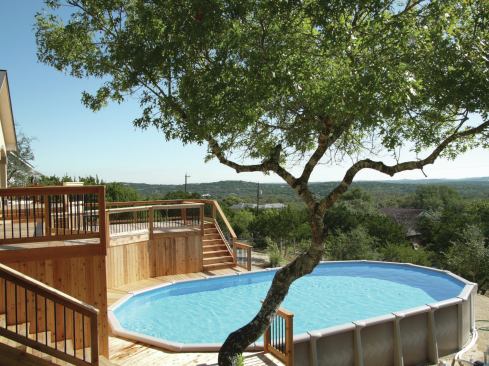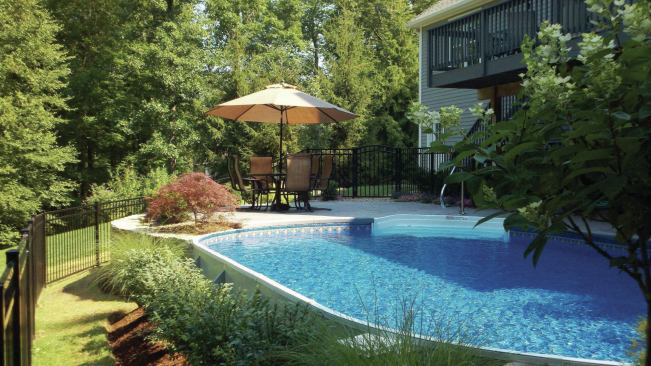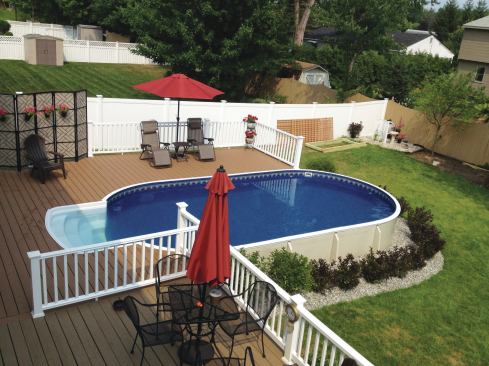ABOVE GROUND POOL & SPA CO.
Abovegrounds advance: Pre-fab pools have evolved over the years,…
Aboveground pools are getting harder and harder to define. Using the term generically, ‘above-grounds’ can refer to temporary pools that are buried partially or fully in the ground. They can be simple circular tubs, oval, square and even free-form.
They can be constructed of steel, aluminum, resin or more sophisticated, space-age material. Some even include expandable deep-ends and built-in stairs.
Traditionally dismissed by custom builders as little more than “tin cans,” abovegrounds now are blurring the lines between inground and temporary by giving homeowners more installation options, shapes and amenities than ever before.
All these variations present ample opportunity for builders to appeal to a broader market. Here, PSN takes a close look at the aboveground pool in all its permutations to help you determine which will find a niche.
A question of quality
Let’s begin with the simple, utilitarian tub that started it all. Despite all the advancements over the years, the conventional rolled-wall pool still sells in large quantities. But even within this segment, quality varies wildly. The less expensive variety is a hot seller online and while inflatable and soft-sided pools fly off shelves at big-box stores like portable air conditioning units during a heat spell.
These no-frills, entry-level vessels mostly are for DIYers who plan to build on Saturday and swim by Sunday. But, too often, products on the low end of the spectrum fail and sour people on the experience of owning a pool altogether, says Maria Rooney, co-owner of Dig-M-Installers, a Baltimore-based firm specializing in aboveground installs.
At the depth of the recession Rooney was fielding the same discouraging question. “It was always ‘What’s the cheapest pool that I can get that you’ll install?’” she recalls.
The durability of these pools was put to the test earlier this year. Hundreds of them crumpled under the weight of heavy snowfall when the polar vortex slammed the aboveground-rich Northeast. Where many homeowners saw a minor disaster, one manufacturer saw an opportunity. Radiant Pools, which makes kits comprising durable panels, launched a social media campaign asking owners to submit pictures of their busted tubs to get a free cover and LED light with the purchase of a new Radiant model.
While the Internet and mega-retailers have staked claim to the low-end market, independent dealers still can cater to homeowners who want something more than a bare bones pool, but don’t have the budget for a professionally designed gunite installation.
“The higher-end stuff is selling because inground pools have become so expensive … it’s pricing a lot of people out,” says Steve Cohen, president and owner of the Wilbar Group, maker of Vogue and Sharkline pools, among others.
However, it’s a niche that too often is overlooked and underserved. Freestanding pools predominately are a retailer’s specialty. Too many retailers are eager to make the sale, but offer little in the way of service. Many are cash-and-carry establishments, meaning they simply sell the pool, along with a list of preferred installers and wish the customer good luck.
Plus, warranties tend to be hit-and-miss. One manufacturer estimated that only about half of all warranties are honored because dealers are bungling the process or give customers the runaround.
“The industry has to grow up and become more service oriented with better responsibility to the customer,” Cohen says.
With at least half a dozen brands in its portfolio, Wilbar, based in Hauppauge, N.Y., is aboveground’s largest manufacturer. Cohen’s father started the business in 1961, and back then the only competition was Doughboy. He’s seen this product category evolve over the years, but new products alone aren’t going to get people excited.
“It’s not a question of inventing new stuff,” he says. “It’s a question of inventing an experience.”
Rising above
As an example of how to do it right, take Pat Walsh’s approach to aboveground pools. He built a business dedicated to the idea that the customer shopping for a temporary pool should receive the same treatment as someone willing to plunk down $55,000 for a custom vessel.
The Above Ground Pool & Spa Co. deals exclusively in what its name suggests. The San Antonio company is the only aboveground dealer in the area that handles all installations in-house and has a Certified Pool Builder on staff. Its showroom is bright, clean and modern. Shoppers are invited to take a dip in displays. Technicians drive a fully stocked “pool store on wheels” to deliver products and provide weekly maintenance services.
In short, Walsh takes abovegrounds seriously.
“Because we do pretty extensive decking and sell much bigger pumps and filters on our pools, and put in second and third returns, we’re on the high end of the aboveground market,” Walsh says.
A wall in his showroom displays industry awards earned for his innovative installations that include retractable covers, multilevel patios and stucco aboveground skirting.
“It’s a powerful sales tool,” he says.
As an aboveground builder in a predominately inground market, Walsh benefits directly from his competition. “Our referral business is huge from inground builders,” Walsh says. “When they can’t sell a $65,000 pool, they suggest an above-ground and they talk about my company.”
Sometimes would-be custom pool owners come to Walsh after suffering serious sticker shock or after finding that their rocky backyards won’t easily accommodate an inground installation.
Another aboveground advantage: It’s not permanent. That makes it the only option for the aspiring pool owner with commitment issues.
“With our pool, we can make it go away,” Walsh says.
Down to earth
Just because a homeowner is settling for a temporary pool doesn’t mean they’re willing to skimp on aesthetics. Where above-grounds lack in prestige, they make up for in versatility. Today’s prefab pool is sturdier than its predecessors, made of heavy-grade steel panels or robust plastic, allowing for more installation options.
With durable panels acting as a foundation wall, some models can be partially or fully buried for a low-profile pool. Surrounded by a deck and smart landscaping, hybrid pools, as they’re called, can be an aesthetically pleasing addition to any backyard. Trimmed with vertical siding — an option on some models — they can even match the home.
Clearly these aren’t tin cans anymore and custom inground builders are beginning to take notice. The ability to customize these pools satisfies their desire to design and construct while offering a more budget-friendly product.
“They realize they’re missing that mid-market in the $10,000 to $20,000 range. They’re able to get those jobs they weren’t normally going to get,” says Eric Gohn, vice president of sales at Fox Pool Corp.
The York, Pa.-based manufacturer, which has about 250 dealers worldwide, recently introduced the Ultimate Pool. Reinforced with 14-gauge steel and equipped with an inground-style skimmer, the Ultimate is developed for homeowners for whom the custom pool is just out of reach.
“We realized there was a price-point difference [between] someone who can’t afford $25,000-plus for a true inground swimming pool, yet they could get an aboveground buried or semi-buried for under $20,000,” Gohn says.
The semi-inground installation is no longer a novelty; it’s pretty much the norm for Dig-M-Installers. Though the Great Recession had many customers wanting flimsy freestanding basins, Dig-M is doing more sophisticated projects these days.
“The quality of customer is really coming back,” Rooney says. “I haven’t seen it this good since 2008.”
Reshaping the market
Radiant Pools is another manufacturer that’s bringing inground ingenuity to the aboveground market. In a category dominated by ovals and circles, a different shape is all it takes to stand apart.
The company unveiled its free-form pools last year. The versatile package comprises insulated panels, the same technology used in airplanes and spacecraft, capable of any installation method.
“That allows the dealer to provide the homeowner with the ability to install a pool in their backyard regardless of any landscaping challenge,” says Collin Sirco, vice president of operations.
Meanwhile, Radiant’s circular models have been upgraded to include double track inside the coping; one for the liner, the other for a cover. The added track addresses one of the aboveground’s biggest setbacks. Closing these pools for the winter typically requires unsightly cords and water jugs to hold the cover down. The internal track solves that problem with an air-tight cover installation. Additionally, you can run a string of fiberoptic lighting along the track for a nighttime ambiance.
That’s the beauty of aboveground pools, dealers say. Homeowners can trick them out with all kinds of accessories — covers, lights, fountains, elaborate decks, salt systems and solar panels, just to name a few. They hold huge upsell potential.
Balancing Act
Part of the appeal of the aboveground pool is that it’s simple. That’s why not all higher-end advancements are successful.
Pat Walsh, president of San Antonio’s Above Ground Pool & Spa Co., remembers carrying a pool that boasted an innovative-for-its-time keyhole shape. “It was very successful for us, but it was not nationally and the manufacturer quit producing it,” Walsh recalls.
There also was the aboveground/hot tub combo. But at $20,000, homeowners felt they were better off getting a custom pool and spa. “Again, we had a bit of success with it, but the manufacturer quit making those, too,” he says.
Sometimes, when aboveground pool makers wade too far into the inground market, they overcomplicate something intended to be an easy sell. “If they come out with another product I’ll try it, but our experience has been that, because it doesn’t do well nationally, the manufacturers bail,” Walsh says.




